Food for the Soul: “Sargent and Fashion” Exhibition
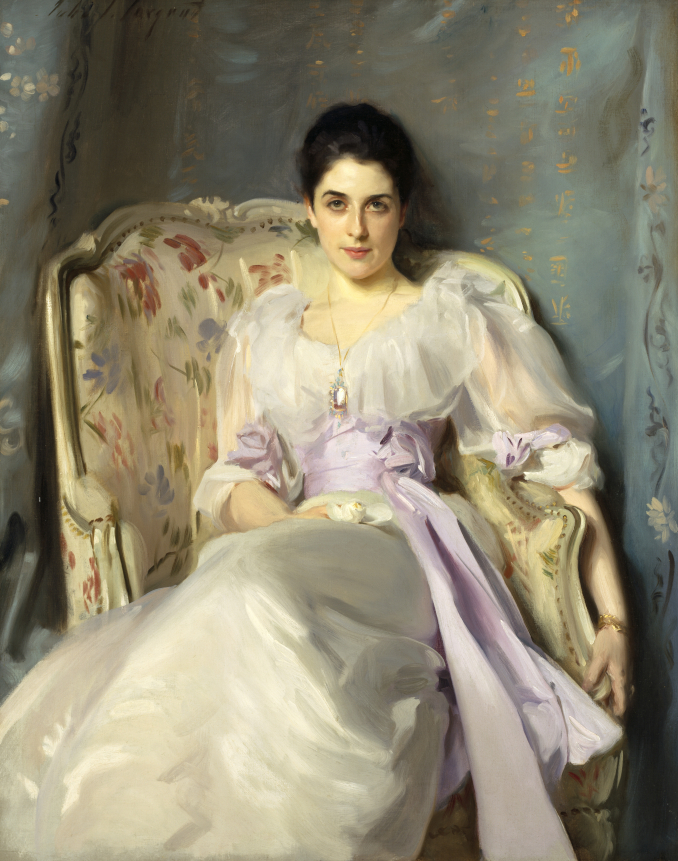
By Nina Heyn – Your Culture Scout
After John Singer Sargent died in 1925, his formal paintings of English and American socialites went out of fashion. Throughout the 20th century, the art world was giddy about other things—abstracts, installation art, pop—visual ideas very much removed from the realistic portraiture that was Sargent’s specialty. In that context, his style seemed to be similar to scores of other 19th-century artists like his teacher Carolus-Duran, James Tissot, or even French academics like Alexandre Cabanel.
A recent exhibition at Tate Britain (joint with Boston MFA), examined Sargent’s use of fashion and theatrical-style staging in his portraiture. At the same time, assembling some of his most iconic paintings also highlighted how different Sargent was from the typical 19th-century portraitist. Even though he spent decades being the most sought-after provider of formal pictures for the salons of French, English, and American society, he would execute these commissions his way—deciding how to dress his models, referencing old masters, or creating studies of painterly issues (e.g., color or composition) on the occasion of delivering a paid work.
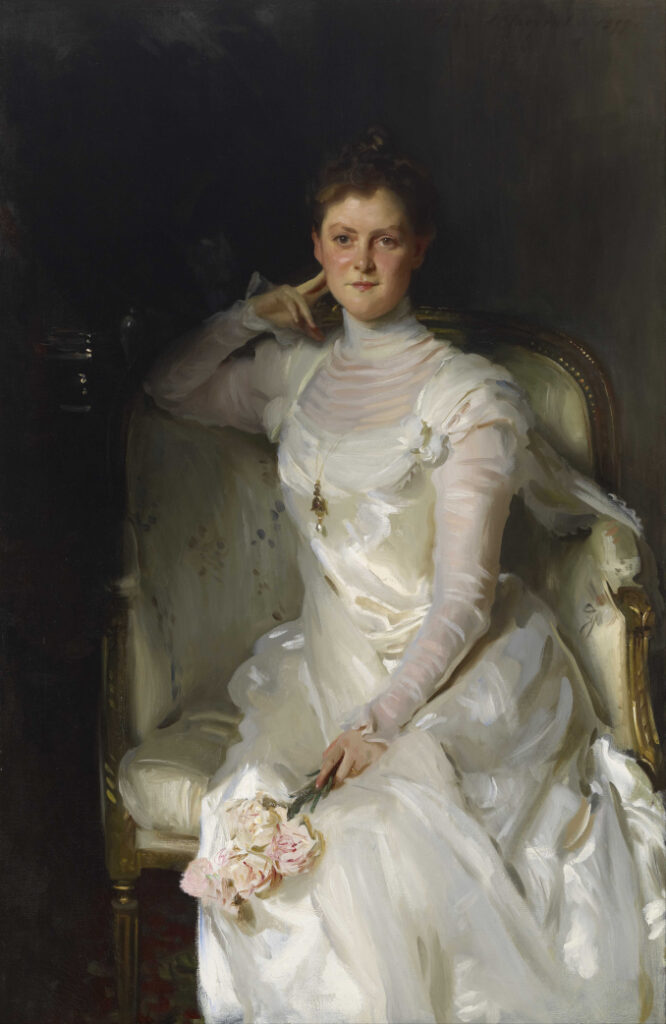
A good example of a painting that is both a formal salon portrait and a color study is his portrait of Sarah Choate Sears. Wife of a Bostonian Brahmin, Sarah was a photographer and an amateur painter herself, as well as an important collector of Impressionist art. Sargent and Sarah were friends—he did portraits of her and her husband, she took his photographs. Sarah would often be mentioned in the society columns, which would describe her colorful and expensive outfits in detail. In Boston’s Museum of Fine Arts, there is a collection of Mrs. Sears’s dresses, mostly from the Parisian couturier Worth, all of them colorful. And yet, Sargent did not use any of these gowns for her formal picture, instead choosing nothing but white, including a large pearl as the only adornment. So many of Sargent’s portraits and genre paintings feature clothes and surfaces in different shades of white. The artist, like many other painters, must have loved the challenge of rendering the ways light affects this “non-color.”

If you look at the detail of this painting, you can see how many shades and hues he used to differentiate the white of the silk, the transparent muslin sleeves and the thick silk of the pillow, all of it contrasted with the pinks of both the roses and the hand.
Painting portrait after portrait of a woman in a pretty dress would be boring, even for a craftsman and even more so for an ambitious artist. No wonder Sargent would sometimes enliven his commissioned work with “Easter egg” references to well-known iconography. A child of itinerant American expats who spent their life traveling around Europe, Sargent had learned art by studying European masters in the galleries of Italy, France, and Spain. One of his artistic heroes was Velázquez; Sargent had studied the painter since teenagehood.
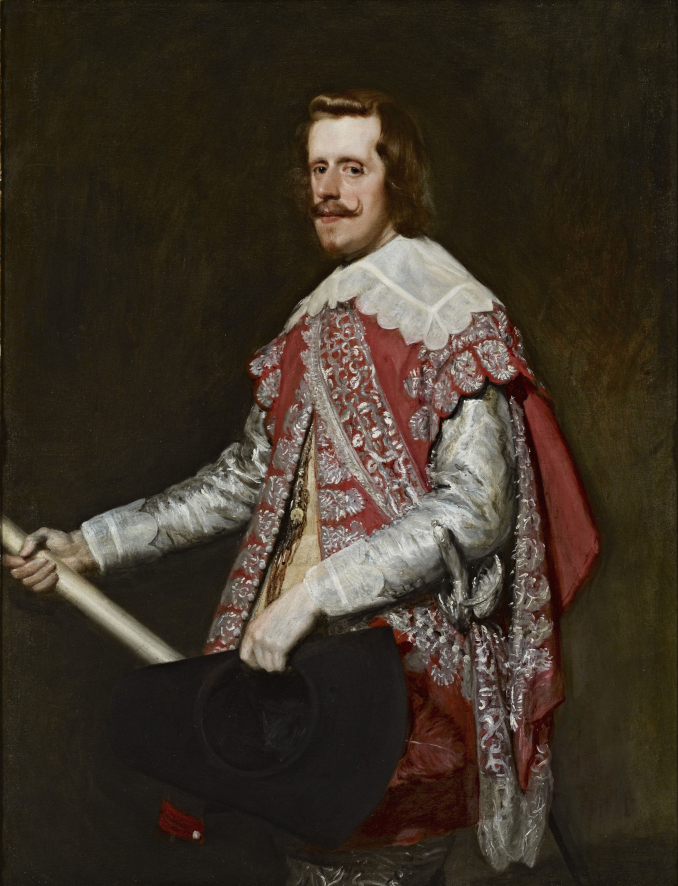
There is more than an echo of the Velázquez portrait, King Philip IV of Spain, in Sargent’s painting of Mathilde Frances Seligman.
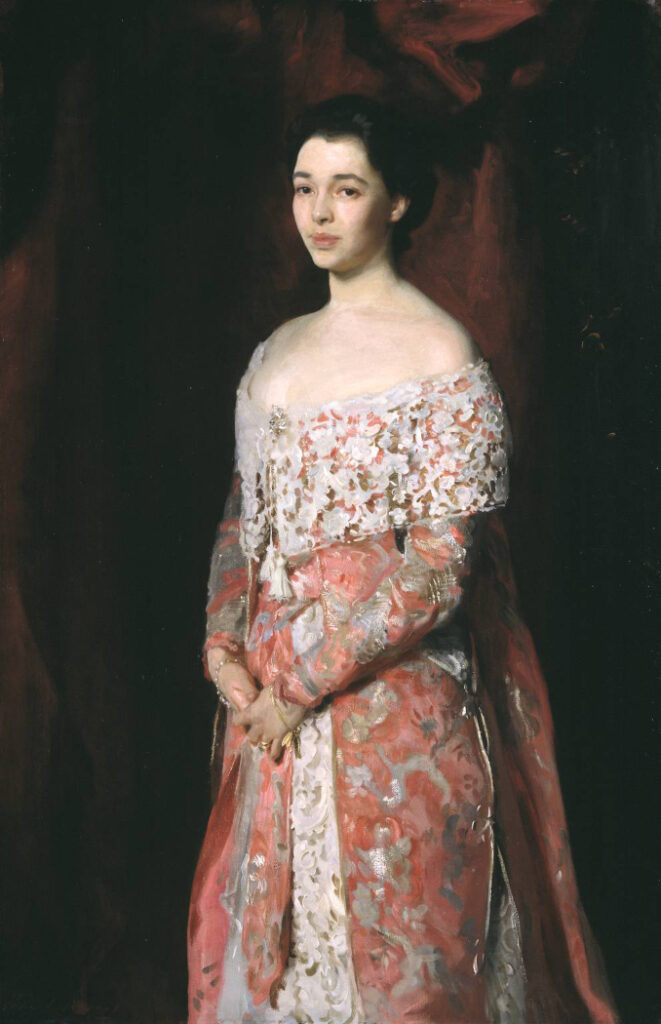
Painted in 1902, Mrs. Leopold Hirsh is a picture of Matilda Hirsch wearing a red brocade dress with a collar of hand-made, antique lace. As is often the case in Sargent’s paintings, the dress looks more draped than actually wearable—arranged just so that the exquisite lace can envelop the sitter’s shoulders. The similarity of the three-quarter pose, the red and white hues of silk brocade, and the sumptuous laced collar are all obvious and delightful references to Velázquez’s portrait of the Spanish monarch. Mrs. Hirsch was a collector of both antique textiles (hence the Spanish lace) and Old Masters paintings, so this idea for a portrait must have equally entertained both the artist and the sitter. Sargent’s typical clients—the British aristocracy and the American plutocracy—had all been collecting artworks that would add grandeur to their palatial residences: large-size pictures by Gainsborough, Spanish masters, van Dyck, and Rubens. A portrait “in the style of Velázquez” would have been a perfect choice for a Gilded Age socialite.
We currently live in an age where even celebrities and the ultra-rich are fine with wearing torn T-shirts and flip flops if it strikes their fancy. At the turn of the last century, society women (and Sargent’s typical clients) would not have had that self-confidence or, conversely, the need to dress down. In a world with rigorous social rules, a beautiful, expensive dress would have been their armor and, in the case of the American nouveau riche, also a way to assert their status and wealth. In a place like Boston, only the richest society ladies could afford both a Sargent portrait and Parisian dresses for posing. Sargent’s fee for a life-size picture would be up to 1000 guineas ($120,000 in today’s dollars) while a single ballgown from the Worth couture house could come to about $30,000 in today’s dollars.
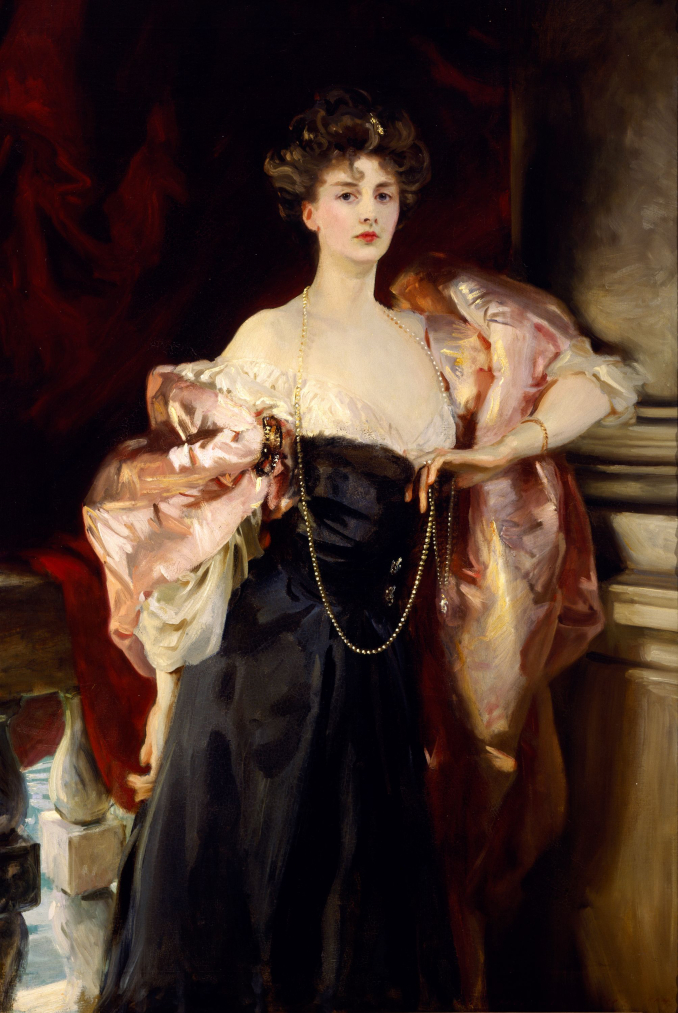
As much as Sargent would have been aware of his clients’ expectation to showcase both the beauty of the sitter and the sumptuousness of the gown, he was an ambitious and modern artist, quite aware that art styles were becoming more and more subjective in the 1900s. No matter how strongly his titled clients insisted on being shown in their best outfits, he would sometimes impose his own vision in a decisive manner. Lady Helen Vincent, Viscountess of Abernon showed up for a sitting in a white dress. He started painting, but after three weeks of sessions, he literally scrapped the entire painting, opting instead for a black dress (which he showed as dangerously falling off the lady’s shoulders) and accented it with acres of pink silk that look more draped than sewn on. The gown does not even look properly finished and constructed. Perhaps Sargent just draped fabrics and invented the rest—after all, he had the utmost familiarity with all the dress styles and the ways that fabrics could showcase a model.

Sargent launched his career in Paris—the art capital and the best professional stage for a young artist—and he vaulted into fame with a portrait that caused a scandal at its exhibition at the 1884 Salon. The picture’s title, Madame *** (also known as Madame X), fooled nobody; Paris society was quite familiar with Amélie Gautreau, the “It” girl of the era who was delighted to pose for Sargent in a decolleté dress with just one strap on. The sexual innuendo of such a wardrobe malfunction was fun for the young artist and his daring model, but it proved to be too much for Victorian-era “polite society.” Eventually, Sargent added the missing strap for the final picture (although the “smoking gun” sketch of the portrait sans strap is available for viewing at the Tate collection), but the damage was done. He came to be considered a risky artist for formal portraits, and the French critics remained hostile.
It was time for a change of scene anyway. Sargent left Paris for assignments in London and Boston, and his subsequent portraits were less scandalizing, perhaps with the exception of the famed portrait of Isabella Stewart Gardner.
Today, 150 years after the Madame X scandal, we no longer consider such portraits as indecent, but there is still something that differentiates Sargent’s brilliant portraits of society women from similar works by other artists, including his direct competitor in the field, Anders Zorn. If you look at Sargent’s pictures together (and the MFA/Tate exhibition enabled that by assembling 60 works in one great show), you can see that so many of these paintings feature women in formal gowns and jewelry who look a bit too bold for their ostensibly respectable social position. They stare at us with a direct, thoughtful gaze, sometimes as if about to speak or rise from their seat, but always very much present and somehow less formal than their social status would have required. This is perhaps the secret of Sargent’s success at the time; he knew how to take his models—many of whom may not actually have been very pretty or daring or intelligent in real life—and make them look engaging, perhaps even looking on with a hint of an illicit promise. He knew how to make the wives of bankers, industrialists, and aristocrats look daring, smart, and above all: interesting.
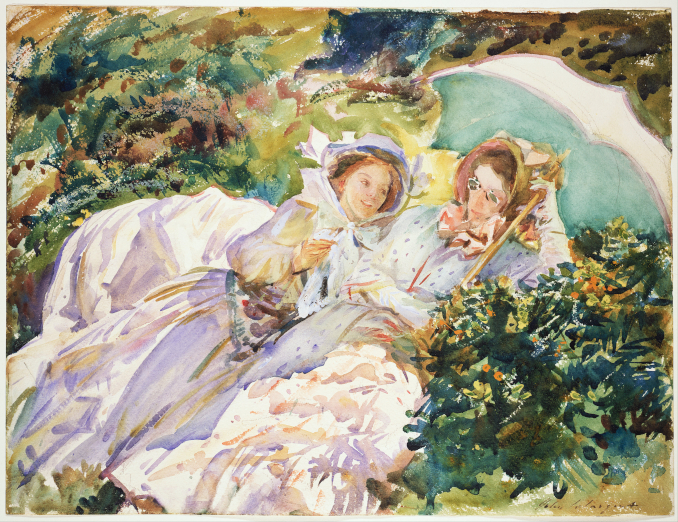
By 1907, almost two decades before he died, Sargent had had enough of society portraiture. In a letter to his friend Ralph Curtis, he mocked: “No more ‘paughtraits.’ I abhor and abjure them and hope never to do another especially of the Upper Classes.” Sargent was done bowing to capricious models and their powerful husbands—he needed to get back his freedom as an artist (he would never stop painting watercolor landscapes or private portraits) and freedom as a man. Only at the end of the 20th century, decades after his passing, would art historians admit (at first obliquely, and now frequently in Sargent biographies) that he was really not a “ladies’ man,” but that, in his very guarded private life, he lived with a succession of men—models, assistants, or friends with whom he would travel around the world, roaming Alpine forest camps, world capitals, exotic cities, and seacoasts everywhere from the Mediterranean to Florida.
Getting off the treadmill of portrait painting gave Sargent the freedom to explore other genres like murals and group portraits, paint models he chose, and accept only those requests that inspired him. The era of his formal life-size salon portraiture passed in the same way that the dressmaker culture of bespoke gowns gave way to simpler designs of ready-made clothing from department stores. Grand palaces and formal salons were also soon to disappear under the burden of inheritance taxes and war damage. We still have museums though, so we can admire Sargent’s virtuoso portraits of the grand ladies of the Belle Époque.
The Sargent and Fashion exhibition took place at the Museum of Fine Arts in Boston (Oct. 8, 2023-Jan. 15, 2024) and the Tate in London (Feb. 22-Jul. 7, 2024).
